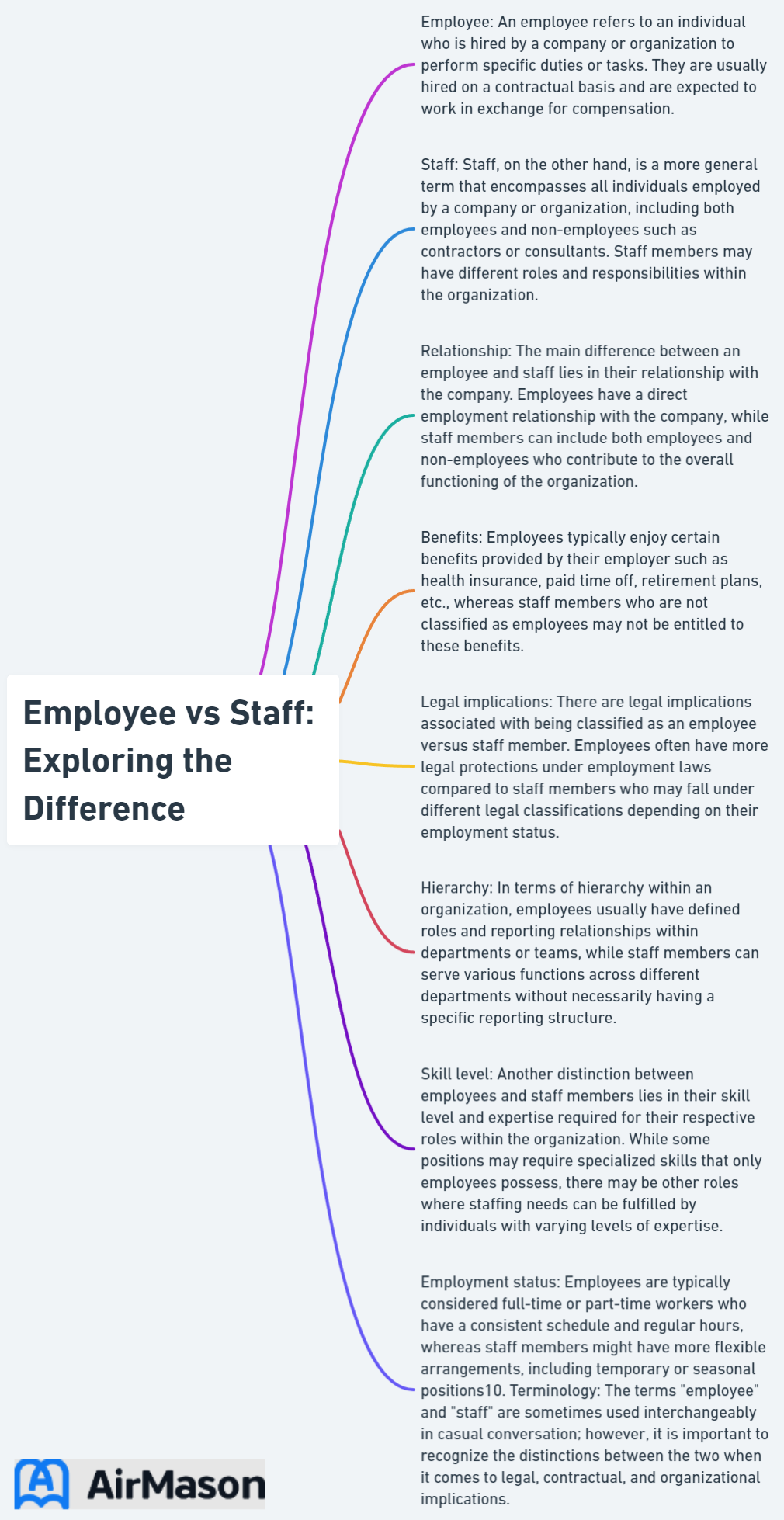
In the ever-evolving world of work, understanding the difference between “employee vs staff” is crucial for both employers and workers. The accurate classification of workers affects rights, responsibilities, and legal obligations for all parties involved. This comprehensive guide will dive deep into the distinctions between employees and staff, the rights and responsibilities of each, and the impact of misclassification. Let’s embark on this enlightening journey to safeguard your interests and ensure compliance with employment laws.
Key Takeaways
- Employee and staff have distinct rights, duties, responsibilities and conditions based on their employment type.
- Employers must evaluate the level of control, importance of work and worker integration to ensure compliance with relevant laws & regulations.
- Clear contracts & regular reviews are essential for employers to assess worker classification & avoid legal/financial issues.
Understanding Employee and Staff Terminology
Grasping the difference between “employee” and “staff” can be a game-changer for both employers and workers, as it affects their rights, responsibilities, and legal obligations. The key to unlocking the mystery lies in understanding the terminology and its implications on various aspects of employment.
We’ll examine the definitions of “employee” and “staff” to see what distinguishes them.

Employee Definition
The term “employee definition” encompasses the formal characterization of an individual’s status within an organization, specifically referring to a person employed under a contract of employment. The employee definition delineates the rights, responsibilities, and contractual obligations between the employer and the person employed. It establishes the parameters that differentiate employees from other types of workers, such as independent contractors or temporary staff. Understanding the nuances of the employee definition is crucial for both employers and employees, as it forms the basis for various aspects, including labor laws, benefits eligibility, and organizational hierarchies. Clear comprehension of the employee definition is essential for effective workforce management and legal compliance within the business environment.
An employee or worker is an individual engaged in a contractual arrangement with an employer, working under a contract of employment. This relationship bestows employees with specific rights, such as protection against being unfairly dismissed, which may not apply to other types of workers. Employment contracts define the characteristics of an employee’s role, including:
- Duties and responsibilities
- Compensation and benefits
- Working time and schedule
- Holidays and leave policies
- Termination conditions
- Ownership of products or ideas produced during employment.
Examples of employee roles span across various industries, from marketing managers in advertising to software engineers in technology, and school teachers in education. In essence, employees are the backbone of any organization, carrying out the tasks and responsibilities that keep the business running smoothly.
Staff Definition
Staff, on the other hand, refers to a collective of individuals employed by an organization, which may include employees, casual workers, and self-employed workers. As a diverse group of personnel, staff members can have different rights and obligations, depending on their specific employment type. This distinction influences workforce management decisions and guarantees fair treatment for all members in line with the law. A key component of the staff is the ‘staff employee,’ who may be regularly scheduled to work a certain percentage of time and can include full-time, part-time, contract, and fixed-term positions, as well as hospital staff employees, per diem employees, student employees, and resource employees, each with specific eligibility for benefits and employment conditions.
Employees, casual workers, and self-employed workers each have different rights and responsibilities. For example, employees enjoy protections like minimum wage and paid holidays. For businesses aiming to recruit such diverse workers effectively, partnering with a google ads Agentur can help create targeted ad campaigns that increase visibility and attract the right candidates. Casual workers often benefit from more flexible schedules but enjoy fewer employment protections.
Self-employed workers operate independently, bearing more financial risks and being responsible for their own tax and insurance contributions. It’s necessary to comprehend these differences to facilitate accurate classification and adhere to employment laws.
Employee Rights and Responsibilities

Employees have specific rights and responsibilities, as outlined in their employment contracts and governed by the Employment Rights Act 1996. These statutory employment rights encompass aspects such as hours, pay, and benefits, with ‘hours worked’ playing a crucial role in determining eligibility for benefits and overtime pay. The number of hours worked within a specific time period can establish limits on the duration and eligibility for various benefits for different types of employment, including temporary employees, payrolled employees, independent contractors, staff employees, hospital staff employees, per diem employees, student employees, and resource employees. In addition, employees have legal obligations, such as adhering to company policies and procedures and fulfilling legal requirements like tax and insurance contributions. Recognizing and meeting these rights and responsibilities, including understanding the impact of hours worked on employment conditions, helps employees foster a harmonious and compliant working relationship with their employers.
Employment Contract
An employment contract is a crucial document that outlines the terms and conditions of an employee’s role, including hours, pay, and benefits. These contracts are governed by various laws, established by federal and state authorities, such as contract law, labor law, wages and hours laws, and tort law. Typical clauses present in an employment contract encompass the scope of employment/job duties, remuneration, termination, confidentiality, non-competition, and non-solicitation. The necessity for an employment contract is highly significant. It provides:
- clarity on the terms of employment
- protection for both parties legally
- prevention of misunderstandings
- job security for the employee
By creating a solid foundation for the employer-employee relationship, employment contracts play a vital role in maintaining a well-functioning and legally compliant workplace.
Legal Obligations
Employees must adhere to company policies and procedures, ensuring compliance with legal requirements such as tax and insurance contributions for tax purposes. As prescribed by the Internal Revenue Code (IRC), employees are obligated to have federal income tax, Social Security, and Medicare taxes withheld from their wages by their employers. Employers in the United States are also generally required to offer health insurance, although there is no federal law mandating this. In addition to tax and insurance obligations, employees must follow company policies and procedures, such as:
- Employee conduct policies
- Equal opportunity policies
- Attendance and time off policies
- Safety procedures
- Technology use policies
By fulfilling these legal obligations, employees contribute to a compliant and harmonious workplace environment.
Staff Composition and Management

Staff composition can vary significantly, encompassing employees, casual workers, and self-employed individuals. This diverse workforce requires employers to adopt different management approaches tailored to the needs and rights of each employment type. We’ll investigate the characteristics of casual and self-employed workers and suggest strategies for effectively managing a diverse staff.
Casual Workers
Casual workers offer businesses the flexibility to adapt to fluctuating workloads and demands. As a casual worker, they have a more flexible working arrangement and fewer rights than employees. Some key characteristics of casual workers include:
- They are typically employed on an as-needed basis without a fixed schedule or extended commitment
- Their working hours can fluctuate from week to week
- They may not receive benefits such as paid leave or health insurance
Although casual workers generally receive a higher hourly rate than full-time employees, they do not have access to the same benefits and entitlements, such as annual leave or paid sick leave. Recognizing the rights and obligations of casual workers is vital for employers to manage such staff fairly and in compliance with the law.
Self-Employed Workers
Self-employed workers operate independently, providing their services to businesses on a contractual basis. They bear more financial risks and are responsible for their own tax and insurance contributions, working on their own account, unlike employees whose taxes and insurance contributions are typically managed by employers.
Managing self-employed workers requires a different approach, as they operate more independently and are not subject to the same rights and protections as employees. Employers must ensure that they treat self-employed workers fairly and in accordance with the specific terms of their contractual agreements while recognizing the unique nature of their working relationship.
Employee and Labor Relations
In the realm of organizational dynamics, effective management hinges on understanding and nurturing positive employee and labor relations. Establishing a harmonious balance between employers and workers is essential for fostering a productive and amicable work environment. Robust employee and labor relations encompass communication strategies, conflict resolution mechanisms, and fair employment practices. By prioritizing open dialogue and equitable policies, organizations can cultivate a workplace culture that not only meets employee expectations but also promotes a collaborative and mutually beneficial relationship between management and staff.
Managing Diverse Staff
The management of a diverse staff comprising employees, casual workers, and self-employed individuals necessitates comprehension of the unique rights and responsibilities associated with each employment type. By being aware of these differences, employers can tailor their management approaches to suit the needs of each worker category, ensuring fairness and legal compliance. Some effective strategies for managing diverse staff include:
- Establishing and maintaining flexible schedules
- Defining clear expectations and communicating regularly
- Offering meaningful work and development opportunities
- Providing support and guidance in managing benefits and retirement savings
By adopting these strategies, employers can create a productive and harmonious working environment that caters to the needs of their diverse workforce.
Determining Employment Status

Determining employment status is critical to ensure accurate classification and to avoid legal and financial complication. Factors such as the level of control an employer has over a worker, the importance of the work to the organization, and the worker’s integration within the company can help ascertain employment status. We will examine these determining factors and touch upon the importance of seeking professional advice when necessary.
Factors to Consider

When determining employment status, factors such as the level of control an employer has over a worker, the importance of the work to the organization, and the worker’s integration within the company must be considered. The level of control an employer has over a worker, for example, can indicate the extent of authority the employer has in dictating tasks, methods, and supervision. The importance of the work to the organization and the worker’s integration within the company can also influence their employment status. By carefully examining these factors, employers can accurately classify workers as employees or independent contractors, ensuring compliance with employment laws and regulations.
Seeking Professional Advice
Consulting professionals while determining employment status can yield multiple benefits. Professionals specializing in employment law or human resources can offer accurate and up-to-date information on the criteria used to determine whether an individual is an employee or an independent contractor. By seeking professional advice, both individuals and businesses can reduce the risk of misclassifying workers, which can lead to legal and financial implications, such as fines, penalties, and back payment of taxes and benefits.
Professionals can assess the specific circumstances and needs of individuals or businesses and provide personalized advice and solutions for a particular job, ensuring accurate classification of workers. When faced with uncertainties or concerns about employment status, it is always advisable to consult with professionals, such as human resources specialists or attorneys, for personal service, guidance, and direction.
The Impact of Misclassification

Misclassification of workers can have significant consequences, leading to legal and financial repercussions for both employers and employees. By understanding the impact of misclassification, employers can take the necessary steps to ensure accurate classification and avoid potential issues.
Legal Consequences
Legal consequences of misclassifying workers may include fines, penalties, and potential lawsuits. Companies that misclassify employees as independent contractors can face significant legal penalties, fines, and unpaid overtime costs, as seen in cases involving Uber, Lyft, and FedEx Ground. The Department of Labor also imposes penalties on businesses of all sizes for employee misclassification, highlighting the importance of accurate classification and compliance with employment laws. To avoid such legal consequences, employers must carefully evaluate the factors that determine employment status and seek professional advice when necessary. By ensuring accurate classification, businesses can maintain compliance with employment laws and regulations while minimizing the risk of costly disputes and legal actions.
Financial Implications
Financial implications of misclassifying workers can involve back pay, unpaid taxes, and insurance contributions. Businesses that misclassify employees may be required to pay insurance contributions such as health insurance premiums, payroll taxes, and unemployment insurance taxes. Misclassified employees, on the other hand, may experience increased tax burdens and be denied benefits and protections legally entitled to employees, such as overtime pay and workplace protections. To mitigate the financial implications of misclassification, employers should ensure accurate classification of workers by conducting regular reviews, implementing clear employment contracts, and seeking professional advice when necessary. This will help maintain compliance with employment laws and minimize the financial impact of misclassification on both employers and employees.
Strategies for Ensuring Accurate Classification

Precise worker classification is imperative to avoid legal and financial complications. Employers can implement various strategies to ensure correct classification, such as creating clear employment contracts and conducting regular reviews. We will delve into these strategies and their significance in maintaining a compliant workplace.
Clear Employment Contracts
Clear employment contracts are vital in defining employment status and protecting the interests of both the employer and the employee. These contracts should outline the terms and conditions of a worker’s role, including their employment status and associated rights. By providing clarity, preventing misunderstandings, and offering legal protection, clear employment contracts lay the foundation for a compliant and harmonious working relationship. Employers should consistently review their employment contracts to ensure they accurately depict the nature of the work being performed and are in compliance with applicable laws and regulations. This will help avoid any potential issues related to worker classification and ensure a legally compliant workplace.
Regular Reviews
Regular reviews are pivotal in detecting any changes in a worker’s role or responsibilities that could impact their employment status. By conducting periodic evaluations, employers can ensure that workers are correctly classified as either employees or independent contractors and as exempt or non-exempt for wage and hour laws.
During these reviews, employers should consider factors such as the level of control, significance of work, and worker’s integration within the company. By consistently evaluating these factors and making necessary adjustments, employers can maintain accurate worker classification and avoid potential legal and financial complications.
Employee in Business
In every thriving organization, understanding the role of an employee in business is paramount. Employee in business refers to the vital contribution of individuals within the corporate landscape. Their dedication, skills, and commitment are the driving forces behind the success of any enterprise. Recognizing the significance of each employee in business is essential for fostering a positive work environment and achieving collective goals. Businesses that prioritize the well-being and growth of their employees often experience increased productivity and long-term success. Emphasizing the value of the employee in business is not only a strategic approach but also a fundamental aspect of creating a harmonious and prosperous work culture.
Summary
In conclusion, understanding the difference between employees and staff and accurately classifying workers is crucial for ensuring compliance with employment laws and maintaining a harmonious working environment. By implementing strategies such as creating clear employment contracts, conducting regular reviews, and seeking professional advice when needed, employers can avoid legal and financial complications while providing a fair and supportive workplace for their diverse workforce. Remember, the key to success lies in knowledge, vigilance, and adaptability.
What is the difference between employees and staff?
Employees are people who are being paid wages or salaries by their employer, while staff can also include contractors and volunteers who don’t necessarily receive payment for their work. Employee is a more formal term that emphasizes the employee-employer relationship, while staff is more general, simply referring to someone part of a team.
Does staff mean employees?
Staff generally refers to all of the employees in an organization, while employee implies one person. However, they can often be used interchangeably with subtle differences such as employee implying paid work.
What is the difference between staff and employer?
Employers are responsible for hiring employees and providing a safe working environment while paying their salaries or wages. Employees, on the other hand, work for the organization and follow their employers’ rules to earn a salary or wage. Employers generate profits from the company which they use to pay their employees.
What rights do employees have compared to casual workers?
Employees have greater rights, including protection against unfair dismissal, than casual workers, who generally have more flexible working arrangements and fewer entitlements.
How can employers ensure accurate classification of workers?
Employers can ensure accurate classification of workers by creating clear employment contracts, conducting regular reviews, and seeking professional advice when necessary to ensure the job is correctly classified.